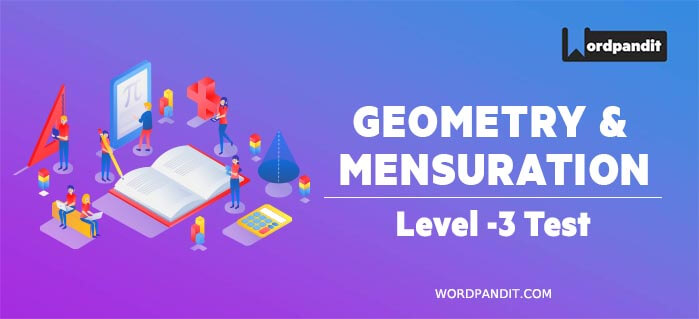- This is an assessment test.
- To draw maximum benefit, study the concepts for the topic concerned.
- Kindly take the tests in this series with a pre-defined schedule.
Geometry and Mensuration: Level 3 Test 3
Congratulations - you have completed Geometry and Mensuration: Level 3 Test 3.You scored %%SCORE%% out of %%TOTAL%%.You correct answer percentage: %%PERCENTAGE%% .Your performance has been rated as %%RATING%%
Your answers are highlighted below.
Question 1 |
PQRS is a square. SR is a tangent (at point 5) to the circle with centre O and TR= OS. Then, the ratio of area of the circle to the area of the square is:

Π/3 | |
11/7 | |
3/ Π | |
7/11 |
Question 1 Explanation:
$\displaystyle \begin{array}{l}Let\text{ }OT=\text{ }x\text{ }Thus\text{ }OR=\text{ }2x\text{ }and\text{ }OS\text{ }=\text{ }x.\\The\,\,side\,\,of\,\,the\,\,square=\sqrt{{{\left( 2x \right)}^{2}}-{{x}^{2}}}=\sqrt{3x}units.\\The~area~of~the~square=3{{x}^{2}}~and~the~area~of~the~circle=\pi {{x}^{2}}\\The\text{ }ratio\text{ }of\text{ }the\text{ }circle\text{ }to\text{ }square\text{ }is\,\pi :3\\Correct\text{ }option\text{ }is\text{ }\left( a \right)\end{array}$
Question 2 |
The adjoining figures show a set of concentric squares. If the diagonal of the innermost square is 2 units, and if the distance between the corresponding comers of any two successive squares is 1 unit, find the difference between the areas of the eight and the seventh squares, counting from the innermost square.


10√2 | |
30 | |
35√2 | |
None |
Question 2 Explanation:
Since the diagonal of the inner most square is 2 cm , the diagonal will increase be 2 cm for every square .
The diameter of the 7th square is 14 cm and that of the 8th square is 16 cm.
The difference in the area is ½ (162-142) = ½ x 60 = 30 cm2
The diameter of the 7th square is 14 cm and that of the 8th square is 16 cm.
The difference in the area is ½ (162-142) = ½ x 60 = 30 cm2
Question 3 |
A cylinder is filled to 4/5th of volume. It is, then tilted so that the level of water coincides with one edge of its bottom and top edge of the opposite side. In the process, 30 cc of the water is spilled. What is the volume of the cylinder?
75 cc | |
96 cc | |
Data insufficient | |
100 cc |
Question 3 Explanation:
If we take the cylinder to be completely filled,
when the water level coincides with the top edge of the opposite side ,
half of the volume spills. Thus
4/5 V – 30 = ½ V
V = 100 c.c
when the water level coincides with the top edge of the opposite side ,
half of the volume spills. Thus
4/5 V – 30 = ½ V
V = 100 c.c
Question 4 |
There is a circle of radius 1 cm. Each member of sequence of regular polygons S1 (n)= 4, 5, 6….., Where n is the number of sides of the polygon, is circumscribing the circle; and member of the sequence of regular polygons S2 (n)= 4, 5, 6, ……where n is the number of sides of the polygon, in inscribed in the circle. Let L1 (n) and L2 (n)= 4, 5, 6, …..Where n is the number of sides of the polygon, in inscribed in the circle. Let L1 (n) and L2 (n) denote the perimeters of the corresponding polygons of S1 (n) and S2 (n), then
$\displaystyle \frac{\left\{ {{L}_{1}}\left( 13 \right)+2\pi \right\}}{{{L}_{2}}\left( 17 \right)}$
$\displaystyle \frac{\left\{ {{L}_{1}}\left( 13 \right)+2\pi \right\}}{{{L}_{2}}\left( 17 \right)}$
Greater than Π/4 and less than 1 | |
Greater than 1 and less than 2 | |
Greater than 2 | |
Less than Π/4 |
Question 4 Explanation:
Since the perimeter of a polygon inside a circle is less than that of the circle and vice versa,
we can conclude that L1(13)>2Π and that of L2<2Π
L1(13)+2Π>4Π
Thus {L1(13)+2Π}/L2(17) = 2
Correct option is (c)
we can conclude that L1(13)>2Π and that of L2<2Π
L1(13)+2Π>4Π
Thus {L1(13)+2Π}/L2(17) = 2
Correct option is (c)
Question 5 |
ABCD is a rhombus with the diagonals AC and BD intersecting at the origin on the (x-y) plane. The equation of the straight line AD x+y=1 is . What is the equation of BC?
$ \displaystyle x+y=-1$ | |
$\displaystyle x-y=-1$ | |
$ \displaystyle x+y=1$ | |
None of these |
Question 5 Explanation:
Since BC || AD, the equation of BC is x+y=k where k≠1
Therefore,
only correct answer possible is (a)
Since no specific distances are mentioned and (a) is a probable answer (d) is rejected.
Therefore,
only correct answer possible is (a)
Since no specific distances are mentioned and (a) is a probable answer (d) is rejected.
Once you are finished, click the button below. Any items you have not completed will be marked incorrect.
There are 5 questions to complete.
List |











